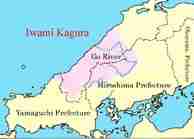[Contents] [Back] [Next] [Section I: Iwami Kagura]
Iwami Kagura
Iwami Kagura first developed as a Shintô ceremonial dance form during the Edo Period (1600-1868) in Ôchi County, Shimane Prefecture (formerly Iwami-no-kuni). Compared to other types of Kagura, it tends to have a clear story line. Two varieties of Iwami Kagura spread to Hiroshima Prefecture. Asuna-kei Takata Kagura was transmitted via the Go River and is now performed in Takata County, and Yakami-kei Yamagata Kagura came to Yamagata County via the Chûgoku Mountain Range. Both have been performed in Hiroshima since the end of the Edo Period. Iwami Kagura apparently spread in two different ways: First, Hiroshima laborers working in Iwami learned the dances while there; at the same time, performers went to Iwami specifically to learn Kagura at the invitation of Kagura masters. But regardless of how the dances were mastered, by the end of the Edo Period there were over one hundred Kagura groups in the region, each with fifteen to twenty-five members. Today, Kagura groups perform two or three ceremonial dances and ten Nô dances at local autumn festivals. Many Kagura performances last until dawn. |
 The recent Kagura boom is due mostly to the frequency of Kagura competitions, at which each Kagura group presents one of its repertoire of eighteen dances to audiences of several thousand. Five to six judges rank each group. These competitions are sponsored by each town's Chamber of Commerce and local Kagura groups. First held after World War II, there are now approximately twenty competitions hosted each year in the northern part of Hiroshima Prefecture. In order to receive a high score at these competitions, Kagura groups must practice year-round. |
|
NPO Hiroshima kagura Art Laboratory |